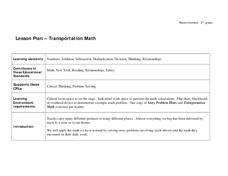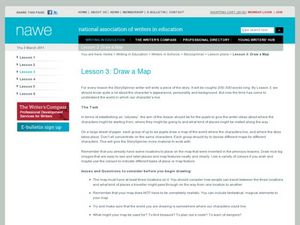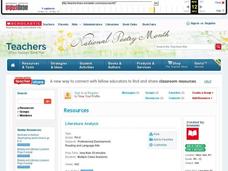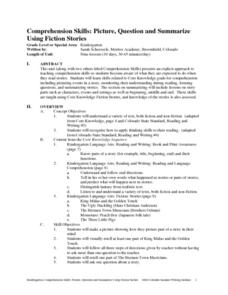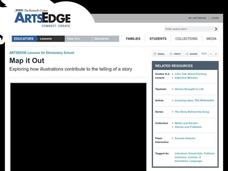Pennsylvania Department of Education
Exploring Key Ideas and Details in Fiction and Nonfiction
Third graders participate in activities to differentiate fiction from nonfiction. In this fiction lesson, 3rd graders describe the elements of a fiction story. Students compare and contrast fiction and non fiction elements. Students...
Curated OER
Transportation Math
Young scholars recognize math problems within stories. In this consumer math lesson, students discover clues to solve math problems within written story problems. Young scholars complete the story problems on a worksheet.
Curated OER
Alchemy and Chemical Symbols
In this alchemy worksheet, students read about how alchemists kept their experiment notes in secret code. Students design their own secret code for the given elements. This worksheet has 2 problems to solve.
Curated OER
Cardboard Weaving
Fifth graders observe artworks of cardboard weaving for their art elements and principles of organization. In this cardboard weaving activity, student create their own and compare artworks of the past and present. Students self evaluate...
Curated OER
Getting Ready to Write
Students watch an online slideshow that shows Cornelia Funke's transition from an illustrator to a writer. They discuss her writing process from the way she gathers ideas to how and where she writes. Next, they work in groups to choose a...
Curated OER
Draw a Map
Students draw a map. In this map drawing lesson students draw a map to show where a character is from and where they are going in the story. Students are writing an odyssey.
Curated OER
Literature Analysis
Students explore the concept of literature analysis. In this literature analysis lesson, students discuss the story elements of a book. Students also discover how to pair share and use each other as a resource.
Curated OER
Literary Analysis - Young Goodman Brown
Why is literary analysis so important? Readers explore writing a literary analysis by reviewing literary elements such as character, metaphor, plot, setting, simile, personification, and style. They read "Young Goodman Brown" by...
Curated OER
Teaching Language Arts in Kindergarten Using Stories, Aesop's Fables, and Tall Tales
Students search into a variety of story elements in the eight lessons of this unit. The title, author, illustrator, setting, main character, problem, solution, events and the story are the components of the lessons.
Curated OER
Write a Story 2
In this creative writing worksheet, learners use the picture to generate ideas for a story. Students also incorporate the elements about the plot and setting for their story.
Curated OER
Share Stories and Discuss
Students explore literature by examining story elements. In this storytelling lesson, students identify the importance of setting, and characters within a story. Students answer questions about their personal opinions on storytelling and...
Curated OER
And the Moral of the Story is...
Students discover the parts of a story through the retelling of a fable as well as characters, plot, and setting. This lesson is completed using the program Pixie to create an online storybook.
Curated OER
Short Story Framework
The class gets creative after listening to a short story containing a definitive structure. They are required to think about character, relationship, and setting, while attempting to show rather than tell, in their writing. Dialogue,...
Curated OER
Novel Analysis
Students read the novel, Lord of the Flies, then write an essay analyzing the novel. They analyze, in small groups, characters, plot, setting, style, symbolism, theme, critical responses, and historical influences
Curated OER
Literary Element/ Conflict
In this language arts worksheet, students use the explanation of conflict to answer the specific questions of examples of the element in the novel.
Curated OER
Comprehension Skills: Picture, Question and Summarize Using Fiction Stories
Students build a variety of comprehension skills through the nine lessons of this unit. Picturing events, monitoring understanding during reading, forming questions, and summarizing stories form the core of the lessons being taught in...
Curated OER
Identifing Elements of Narrative Writing
Students explore the concepts of narrative writing. They identify the basic elements in narrative writing such as the setting description, characters, conflict, climax and resolution. Using five adjectives from a previous spelling unit,...
Curated OER
Egg Carton Stories
Students create stories with better structure when they are able to focus on its characters, setting, and plot. Teacher creates settings, character, and problem cartons with information written on strips of paper.
Curated OER
I'm Thinking Of A Story
In this literature lesson, pupils listen to folk tales and then discuss the main ideas and plot of the story. Additionally, students guess what story is being talked about when their teacher describes the main idea and plot. Good...
Curated OER
Short Story Lesson
Students examine short stories and identify setting, characters, points of view, theme and plot. This lesson develops an appreciation and understanding of short stories.
Curated OER
Writing a Historical Fiction Story
Young scholars create a historical fiction story. In this historical fiction lesson, students choose a time period to use as their setting. They create a story with true elements but fictional characters and plot.
Curated OER
Map It Out
Explore how illustrations add to a story. Young learners will look at picture books to see how the pictures tell the story. They create illustrations to go with a chosen story, and then flip the activity so they have to write a story to...
CPALMS
Analyzing Vonnegut's View of the Future and His Commentary on the Present in Harrison Bergeron
Kurt Vonnegut's short story "Harrison Bergeron" engages adolescents with its theme about the dangers of complete societal equality. Learners complete a graphic organizer to track literary elements in the story, as well as an inference...
Curated OER
Cinderella Folk Tales: Variations in Plot and Setting
Students examine plot and setting of Cinderella, and how it changes as it is translated into different cultures, discuss universal literary elements of the Cinderella story, and write narratives with original settings and plots...
Other popular searches
- Short Story Elements
- Elements of a Story
- Fable Story Elements
- Teaching Story Elements
- Identify Story Elements
- Story Elements Chart
- Analyze Text Story Elements
- Story Elements Character
- Story Elements Collage
- Identifying Story Elements
- Elements of a Short Story
- Short Story Elements Quiz



